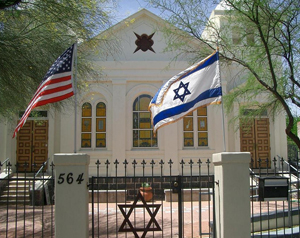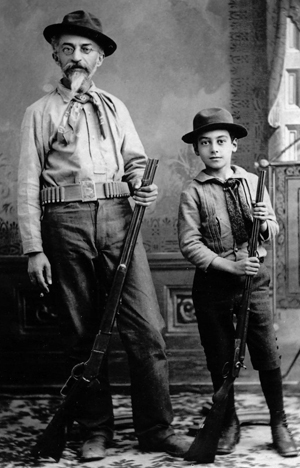Where L’Chaim Illuminates
Head to Downtown’s Jewish History Museum to learn local Jewish lore that goes beyond this month’s Hanukkah candles and Christmas-Day Chinese dinners.

The front of the Downtown Jewish History Museum. photo courtesy Jewish History Museum
To delve into the sometimes-odd-but-always-fascinating corners of Southwest Jewish history, you need to turn onto the road less traveled: Go south on Stone Avenue, past the police station and the cathedral, to the simple, classical revival structure that was the original synagogue in the Arizona Territory, in fact the first house of worship for Jews throughout the Southwest.
There’s lots of what you might call the stranger side of Tucson Jewish folklore there to be discovered.
Before 564 S. Stone Ave. was re-opened as the Jewish History Museum in 2001, iterations as a Mexican radio station and a flophouse collected in the 1910 building’s long and storied history. Abandoned after Temple Emanu-El moved further east from Downtown in the 1940s, the building thankfully survived and is now a restored showcase of one-offs and collections depicting a rich regional Jewish history. The museum specializes in found objects — amazing stuff that somehow made its way out of owners’ hands and into this house of treasures.
Take, for example, one of the first 48-star flags flown in Tucson (February 14, 1912). Mercantile businessman Charlie Gold flew the flag over his shop on Congress Street, just west of Church Avenue. There’s also a Tucsonan-owned pocket watch with a Hebrew-inscribed time-face that was given to Jewish soldiers who served the Kaiser during World War I. And there’s an 1897 centavo Mexican coin, which was in the time capsule placed in the cornerstone laid at the synagogue in 1910.
A timeline of western Jewish lore and the personalities who shaped it surround the meticulously-preserved original woodwork and pews as well as the cases of memorabilia. The Jews of the late 19th and early 20th century territorial Tucson were an interesting mix of miners, bankers, merchants and businessmen prominent in the entertainment business. Some of these Jewish pioneers include Drachman (earliest Tucson Jewish businessman), merchandiser Zeckendorf (and nephew Steinfeld), Mansfeld (founded first public library and helped found UofA), Levin (founded first entertainment district, whose descendants include Linda Ronstadt), and Strauss (Tucson’s first Jewish mayor). Gabby Giffords and her family also are highlighted (Gabby’s dad Spencer became a bar-mitzvah at Temple Emanu-El, when it was still on Stone Avenue, and just last month Gabby, a member of Congregation Chaverim, was honored with the Museum’s 2013 Jewish Heritage Award.)

This picture of Charles Strauss – the first Jewish mayor of Tucson, with his son – can be viewed at the Jewish History Museum. photo courtesy Jewish History Museum
Local volunteers conduct enthusiastic, informative tours, regaling visitors with tales of territorial Jewish oddities. One story worth listening to involves Southern Arizona mine owner Mark Lulley, the scrappy proprietor of Wandering Jew Mine who captured bear cubs in the Santa Rita mountains. Lulley apparently made a saloon wager which called for him to walk the bears down Pennsylvania Avenue to the White House if McKinley was re-elected in 1900. The January 1901 newspaper clip of McKinley’s inauguration, and also Lulley’s presentation of the Southern Arizona bears to the National Zoo, are on display through December at the museum.
Because you can’t look at memorabilia all the time, the museum also is ringleader of a number of quirky Tucson happenings, including trivia and Brooklyn nights. It also masterminds the annual Christmas Day Chinese Dinner; however, this year the overworked and tiny volunteer museum staff has decided to give the formalized Chinese-food-for-Christmas dinner a rest. Would-be yentls, however, are encouraged to continue the tradition via their own serendipitous gatherings at Chinese restaurants across the city on Dec. 25.
And instead of Christmas day sesame chicken, museum staffers hope you’ll join them New Year’s Day, when a museum gathering will offer 2014 New Year refreshments, a fashion show and the kick-off of a new exhibition.
Combining Judaism and art, the Jewish History Museum’s exhibition will feature Ketubahs, beautifully-decorated Jewish marriage contracts written in Aramaic, and wedding dresses. Even Tucson has a long tradition of creation and signing these formal contracts that are ceremonial works of Jewish art and the January exhibition, with its collection of dresses and related items dating back to the late 1800s, should be perpetually absorbing.
“You don’t have to be religious to enjoy it,” promises Dr. Barry Friedman, the hardy Jewish History Museum president and all-around advocate. “The museum is a carefully-preserved collection-turned-public treasure that’s relevant, incredibly diverse and phenomenal fun.”
In October, in collaboration with the Jewish Federation of Southern Arizona, the museum opened The Holocaust History Center – a walk-in, floor-to-ceiling installation that’s a poignant yet ultimately inspirational depiction of over 130 Holocaust survivors who made Southern Arizona their home.
Photos and digital displays immerse the visitor in a tiny space, opened adjacent to the Jewish History Museum in a portion of a partially-restored 1880s territorial purchased by the museum.
There is a Jewish custom of placing stones rather than short-lived flowers on graves as a sign of permanence. A bowl of small stones sits at the entrance to the museum’s Holocaust center, for all who wish to leave such an offering for the survivors.
Open to the public Wednesday-Thursday, Saturday-Sunday from 1 to 5 p.m., and Friday from noon to 3pm, the small museum (JewishHistoryMuseum.org) and its carefully-curated homage to Tucson Jewish lore helps you travel back in time. There’s everything to surprise you, with displays that treat Tucson history with respect and thorough documentation. A visit here also will make you laugh. Your eyes will be opened and so will your heart.
Category: Arts, Community, DOWNTOWN / UNIVERSITY / 4TH AVE, Events




